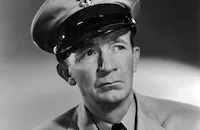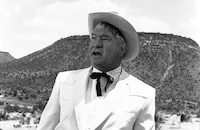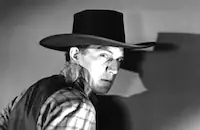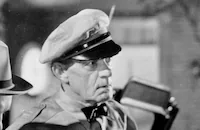The Westerner

Brief Synopsis
Cast & Crew
William Wyler
Gary Cooper
Walter Brennan
Fred Stone
Doris Davenport
Forrest Tucker
Film Details
Technical Specs

Synopsis
Cole Harden, a wandering cowhand, is brought before Judge Roy Bean on the charge of stealing a horse, a certain death penalty in Bean's court, but Cole cleverly talks himself out of his predicament by pretending to know the idol of Bean's life, British actress Lily Langtry, known as "the Jersey Lily." Bean reverses Cole's death sentence, and the cowboy sets out for California. Along the way, he meets homesteader Caliphet Mathews and his daughter Jane-Ellen and becomes involved in the homesteaders' struggle against the cattle ranchers. This puts him in direct conflict with Bean, who is the law behind the ranchers. When Cole succeeds in convincing the judge to remove the cattle from the homesteaders' land in return for a lock of Lily's hair, it seems that peace will return to the valley. Not to be defeated, the judge and his gang set fire to the homesteaders' fields and trample Mathews to death when he attempts to save his house. Embittered, Jane vows to remain, and Cole rides to Ft. Davis to swear out a warrant on the judge for murder. Despite his status as a wanted murderer, the judge insists on riding to Ft. Davis to see Lily perform. As the lights in the opera house dim, Cole comes for the judge, and the last thing that Bean sees before he dies is his beloved Lily. His job accomplished, Cole returns to Jane and the land.

Director

William Wyler
Cast

Gary Cooper

Walter Brennan

Fred Stone
Doris Davenport

Forrest Tucker
Lilian Bond
Paul Hurst

Chill Wills

Charles Halton

Tom Tyler

Dana Andrews
Roger Gray
Trevor Burdette
Arthur Aylesworth
Lupita Tovar
Julian Rivero

Lucien Littlefield
Jack Pennick
Arthur Mix
Helen Foster
Connie Leon
Charles Coleman

Lew Kelly
Heinie Conklin
Corbet Morris
Stanley Andrews
Henry Roquemore
Hank Bell
William Steele
Blackjack Ward
Jim Corey
Buck Moulton
Ted Wells
Joe De La Cruz
Philip Connor
Captain C. E. Anderson
William Gillis
Buck Connors
Dan Borzage
Speed Hanson
Gertrude Bennett
Miriam Sherwin
Annabelle Rousseau
Phil Tead
Bill Bauman
Frank Cordell
Crew
James Basevi
Niven Busch
Paul Eagler
Samuel Goldwyn
Samuel Goldwyn
Julia Heron
Stuart N. Lake
Fred Lau
Daniel Mandell
Rudolph Maté
Walter Mayo
Lewis Milestone
Irene Saltern
Irving Sindler
Blagoe Stephanoff
Archie Stout
Jo Swerling
Dimitri Tiomkin
Gregg Toland

Videos
Movie Clip


Trailer
Hosted Intro
Film Details
Technical Specs

Award Wins
Best Supporting Actor
Award Nominations
Best Art Direction
Best Writing, Screenplay
Articles
The Westerner
Cooper was not at first interested in the role of Cole Hardin because, in the early drafts of the script, the film revolved around the character of Bean. "I couldn't figure for the life of me why they needed me for this picture," Cooper said, "I had a very minor part. It didn't require any special effort." Screenwriters Niven Busch (Duel in the Sun, 1946) and Jo Swerling (It's a Wonderful Life, 1946) expanded the role (additional material was written by playwright Lillian Hellman) but it was still not to Cooper's satisfaction. Finally, when Goldwyn threatened to sue the actor for violation of his contract, Cooper agreed to play the lead, "with the express understanding that I am doing so under protest." Cooper underestimated the script, for it stands among the most highly regarded films of his career, though he was entirely accurate in predicting who would get the glory. For his performance as the ornery Judge Roy Bean, Walter Brennan won the Academy Award for supporting actor (his third Oscar in five years). Cooper was not nominated, though he would win the Oscar the following year for Sergeant York (1941).
Goldwyn handsomely budgeted the film at $1 million (a substantial amount for a "mere" Western), allowing four weeks of location shooting eight miles outside of Tucson, Arizona. He also funded the herding of 7,000 head of cattle, which was at that time the most that had ever been gathered for a motion picture sequence. While on location, the cast and crew would rise each day at six a.m., recalled Freda Rosenblatt, who traveled with the company, "There would be snow and ice on the ground. By ten the sun would come out and we'd bake. We'd shoot till sundown. Then we'd go back to the Santa Rita Hotel in Tucson and have dinner. At night we'd watch rushes from the day before. Lots of times Willy would want a rewrite for the next day. The crew, including Willy, didn't get much sleep. In the morning we'd start all over again."
Wyler planned to cast his wife, Margaret "Talli" Wyler in the role of Jane-Ellen, but Goldwyn was insistent that the part go to Davenport, who had only appeared in bit parts, and whom the producer believed had breakthrough potential. The Westerner failed to make a star of the actress, and she retired after making one other film, Behind the News (1940).
In the 1940s, the Western entered a new era, leaving behind some of the clear-cut divisions between good and evil that was a defining trait of the genre, but one that limited its thematic complexity. The Westerner was the first in a series of cowboy pictures that grayed the white hat/black hat distinctions of the formula Western. The friendship between Hardin and Judge Bean is the true focus of the film -- much more so than the Texas range wars or even Hardin's relationship with Jane-Ellen. Hardin and Bean enact a dark romance of trickery, back-slapping camaraderie and cold-blooded murder that one sees echoed again and again in the timeless Westerns of its decade -- between Wyatt Earp and Doc Holliday in My Darling Clementine (1946), Pat Garrett and Billy the Kid in The Outlaw (19 43), and Thomas Dunson and Matt Garth in Red River (1948).
Perhaps the shadow of World War II helped cultivate this more cynical approach to the once rigid codes of the Western, as if filmmakers were acknowledging that a chapter of American film -- like the West itself, the very source of so many cinematic myths and legends -- had come to a close. This sense of loss gives films such as The Westerner their elegiac tone, and allowed the genre to take on new emotional resonance.
Much of the film's haunting tone is due to the brilliant camerawork of Gregg Toland (Citizen Kane, 1941). The typically sunny West is, through Toland's lens, a place of looming clouds, dingy barrooms and heavy shadow. One scene in particular showcases Toland's work, that in which Hardin stands silhouetted at nightfall amid the farmer's burned-out crops, as Jane-Ellen reads over the grave of her father from a Bible, its pages charred by the fire that has destroyed her home. This scene -- with its skeletal stalks of scorched corn -- no doubt helped James Basevi score an Academy Award nomination for art direction. Basevi also designed an elaborate recreation of the Fort Davis Grand Opera House, where the film's climax is played out in an especially memorable sequence.
Wyler and Toland made seven films together, including Dead End (1937), Wuthering Heights (1939), and The Best Years of Our Lives (1946). At first their working relationship was strained. "I was in the habit of saying, 'Put the camera here with a forty-millimeter lens, move it to this way, pan over here, do this.'" remembered Wyler, "Well, he was not used to that. Making Westerns at Universal, I directed the camera work. I considered it part of my job. You don't do that with a man like Gregg Toland... He was an artist."
For Wyler, The Westerner was a homecoming of sorts. He had gotten his start as director by proving the speed (and quality) at which he could churn out two-reel Westerns -- a total of 21 between 1925 and 1927. In 1930 he abandoned the genre after The Storm, but would return to the American West a final time in 1958 with The Big Country.
Director: William Wyler
Producer: Samuel Goldwyn
Screenplay: Jo Swerling and Niven Busch
Based on a story by Stuart N. Lake
Cinematography: Gregg Toland
Production Design: James Basevi
Music: Dimitri Tiomkin and Alfred Newman
Cast: Gary Cooper (Cole Hardin), Walter Brennan (Judge Roy Bean), Doris Davenport (Jane Ellen Mathews), Fred Stone (Caliphet Mathews), Chill Wills (Southeast), Lilian Bond (Lily Langtry).
BW-100m. Closed captioning.
by Bret Wood

The Westerner
Quotes
Don't spill none of that liquor, son. It eats right into the bar.- Judge Roy W. Bean
Shad Wilkins, you've been tried and found guilty of the most serious crime west of the Pecos, to wit: shooting a steer. Do you got anything to say for yourself before the sentence of the court is executed?- Judge Roy W. Bean
I told you they shot at me first. I didn't mean to kill that steer on purpose. I was aiming at the man.- Shad Wilkins
It's your bad luck you missed him. That's the trouble with you sodbusters...you can't shoot straight. Shad, may the Lord have mercy on your soul.- Judge Roy W. Bean
Trivia
Notes
Although onscreen credits list the character played by Dana Andrews as "Bart Cobble," the Variety review lists his name as "Hod Johnson." According to news items in Hollywood Reporter, the film was shot on location near Tucson, AZ, in a town that was established for the express purpose of being a headquarters for the crew. When the newly made town was founed, then governor R. T. Jones was present. Shooting was briefly delayed when star Gary Cooper was injured in a fall from a horse. Later items in Hollywood Reporter note that in February 1940, director Lewis Milestone and photographer Rudolph Maté shot additional scenes for the film. The Daily Variety review adds that the picture cost approximately $2,000,000 to produce. Judge Roy Bean, who called himself "the Law West of the Pecos," was a real person. He was justice of the peace in Langtry, Texas, named after British actress Lily Langtry whom he loved from afar. Walter Brennan won his third Academy Award for his portrayal of Judge Bean in this picture. Brennan was the only performer to win three Academy Awards for Best Supporting Actor. The film was also nominated for an Academy Award for Best Original Story and Best Art Direction. According to modern sources, Cooper almost broke his contract with Goldwyn because he did not want to play the role of Cole Harden. Modern sources also note that Goldwyn attempted to distribute the picture through Warner Bros., but United Artists prevented this by threatening Warners with a lawsuit. Modern sources state that Lillian Hellman and Oliver La Farge did rewrites on the script, and that William Wyler, dissatisfied with Dimitri Tiomkin's score, had Alfred Newman rewrite it, although Tiomkin received sole screen credit.
In September 1940, Gary Cooper and Walter Brennan starred in a Lux Radio Theater version of the story. Several other films have been based on the exploits of Judge Roy Bean. A character in RKO's 1938 film The Law West of Tombstone was loosely based on the judge, and the 1972 First Artists Production The Life and Times of Judge Roy Bean, directed by John Huston and starring Paul Newman and Huston, detailed the exploits of the judge.

















